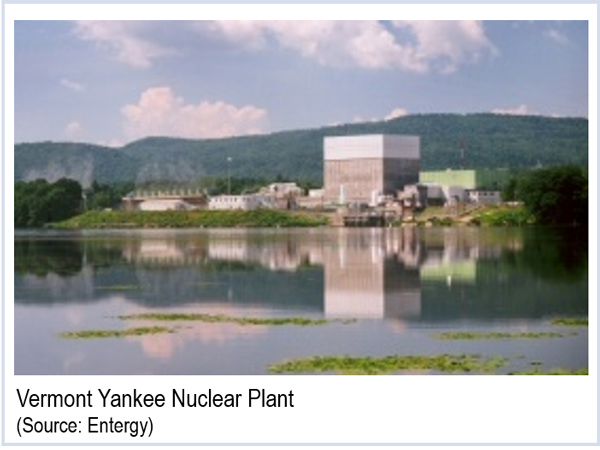
That’s right: Workers at Los Alamos National Laboratory have long used cat litter to absorb liquid nuclear waste. But not all cat litter is alike, as pet owners around the world have long known. Instead of using inorganic clay litter, workers apparently used Swheat Scoop organic litter inside troubled drum 68660.
And while Swheat Scoop may appeal to those seeking a green solution to cat cleanup, it does not work well in certain industrial settings. “Experiments showed that various combinations of nitrate salt, Swheat Scoop, nitric acid and oxalate self-heat at temperatures below 100 C. Computer modeling of thermal runaway was consistent with the observed 70-day birth-to-breach of drum 68660,” according to the report.
The incident caused the drum to burst open, spreading radioactive plutonium, americium and uranium throughout the facility. The plant closed after the incident, but the department hopes to open it next year.
More: NPR
DOE Pledges $450 Million for Modular Reactor Design

More: Department of Energy
NRC Questions Entergy’s Use of Decommission Funds

“We have identified several line-item expenditures that, at least at first glance, do not appear to be permissible under NRC regulations in this area,” NRC spokesman Neil Sheehan said. NRC is asking Entergy for more information before making a ruling on the spending. Any disbursements from the fund in the early stages of decommissioning mean it will take longer for it to reach $1.2 billion, the estimated total cost of dismantling and cleaning up the reactor site.
More: Times-Argus
Virginia Senator Questions FERC on Pipeline Hearing Rules

Virginia Sen. Mark Warner has written a letter to the Federal Energy Regulatory Commission after opponents to a proposed pipeline through the rural central part of the state said they felt short-changed by the public input process.
Warner asked FERC Chairman Cheryl LaFleur to make clearer the process for signing up to comment during public meetings. The request came after opponents to the proposed Atlantic Coast Pipeline showed up at a scoping meeting in Nelson County earlier this month. They had been told to show up a little before the 7 p.m. meeting to sign up to comment, and found that Dominion Resources, one of the pipeline’s owners, had already signed up dozens of supporters to speak.
Friends of Nelson member Ernie Reed said the public comment process needs to slow down and allow all members who want to talk a chance to be heard. “To just give it the time required and the time that’s necessary is all we’re asking, but it’s the type of an ask that Sen. Warner has now made, and we’re hoping FERC responds in a positive way and gives us and the rest of the public the opportunities that we deserve,” he said.
More: NBC29
FERC Tells Planners of Ohio Pipeline to Find Less Populated Route

The proposed pipeline is being built to move gas from Ohio’s Utica Shale fields. FERC noted in its letter to Nexus that the project is generating “a large volume of public comments.” The city, in its filing with FERC requesting that the pipeline route be adjusted, said the route was “hastily drawn and ill-conceived with no respect to the human and environmental concerns.”
More: Associated Press
Departure of Harry Reid Could Spell Rebirth of Yucca Repository
The announcement by Sen. Harry Reid (D-Nev.), long an opponent of the Yucca Mountain nuclear waste repository, that he would not seek reelection in 2016 could signal a rebirth for the project. According to Bloomberg, Senate Democrats who had been loath to vote against Reid on the project may be more likely to with him gone. The project, which has so far cost U.S. taxpayers $15 billion, went dormant after the Obama administration said it wasn’t a “workable option” and cut funding.
More: Bloomberg
IG Investigating NRC Actions in PG&E Quake Standards

Fault lines were discovered after construction of the plant began in 1968, but more were found in 2011, and in 2013 PG&E changed the plant’s final safety report to use a less conservative method of making seismic-damage calculations.
Investigators are looking into that change of procedure, as well as charges by a former NRC inspector at the plant. That inspector, Michael Peck, said the plant was no longer operating within the parameters of its license. Peck has said his concerns were ignored by both NRC and PG&E. “The ground motion is way beyond what was analyzed in the original license,” he said in an interview Wednesday. “They basically bypassed that whole process. We’re not enforcing it, and I don’t know why. We gave them a pass.”
PG&E said the plant is observing all NRC regulations and is safe.
More: San Francisco Chronicle (subscription required)
First Ocean Wind Energy Research Facility to be Built off Va. Shore
A 12-MW offshore wind energy test facility will be built off the coast of Virginia Beach, the first research lease to be executed in federal waters. The Bureau of Ocean Energy Management announced that two 6-MW wind turbines will be installed and operated by Dominion Virginia Power. Information gathered by the test facility will be used to help researchers and developers of future wind energy facilities offshore, according to BOEM.
The towers will be built about 24 miles off Virginia Beach. Power is to be delivered to the grid through subsea cables.
Environmentalists applauded the news. “Full-scale development of offshore wind can create thousands of clean energy jobs and address climate change while displacing Dominion’s plans for new gas power plants and an unwise investment in a new nuclear reactor at North Anna,” said Glen Besa, director of the Virginia Chapter of the Sierra Club.
More: Delmarva Now; Daily Press
FERC Denies IMEA’s Capacity Waiver for 2018/19

In its ruling, FERC distinguished IMEA’s waiver request from a similar one it granted last year (ER14-1681). In that decision, FERC deemed IMEA did not have adequate notice to prepare for its ComEd LDA being modeled for the first time with a separate variable resource requirement curve.
And IMEA’s previous request was not protested.
This year, PJM’s Independent Market Monitor and the Illinois Commerce Commission urged FERC to reject another waiver. (See Illinois Regulators, IMM Line up Against IMEA Capacity Waiver Request.)
“PJM and IMEA note that the treatment of IMEA’s external resources is being addressed through the PJM stakeholder process, which will allow for concerns related to reliability and harm to third parties to be vetted and, as appropriate, inform any proposed changes to the Reliability Assurance Agreement or other PJM governing documents,” FERC said.
“We recognize that denial of IMEA’s waiver for the 2018/2019 delivery year will require IMEA to adjust its capacity portfolio for the planning year, but we encourage IMEA and PJM to continue to work on a longer term solution.”
More: ER15-834
Compiled by Ted Caddell


